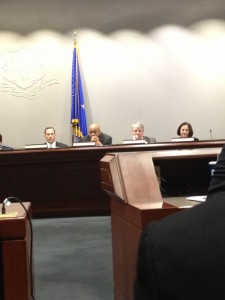On Friday, February 15, the Education Committee of the Connecticut General Assembly held its first public hearing of the new year in the Legislative Office Building, room IE. The room was packed with various members of the media and concerned citizens, and the agenda was full; Representative Andrew Fleischmann and Senator Andrea L. Stillman ruled over the hearing and were responsible for the proceedings. It began a few minutes after 11 am with the promise that it would be an important day for the future of Connecticut’s children. The first bill up for review on the agenda was H.B. No. 6357, entitled, “An Act Implementing the Budget Recommendations of the Governor Concerning Education,” which was presented on behalf of Governor Daniel P. Malloy by Ben Barnes, Secretary of the Office of Policy Management.

The bill includes 28 different sections, all of which are the Governor’s budget recommendations to be implemented by July 1, 2013. Myra Jones Taylor, Director of Early Childhood Planning, and Stephen Pryor, the Commissioner of the State Department of Education accompanied Secretary Barnes on the stand. Taylor declared the Governor’s proposal to be one of the boldest and most comprehensive plans attempted by any state. Each speaker was only allowed three minutes to make their case, a task that proved difficult due to the complexity of their proposals.
Barnes spoke first about Bill No. 6357 and provided the committee and audience with a brief summary of the more important components of the governor’s education funding initiative. He began by discussing the governor’s education mission that focuses on looking towards new ways of cutting costs while simultaneously raising the quality of Connecticut schools.
One of the implementations the governor is seeking to execute, which sparked a large amount of controversy amongst the committee, is the radical re-shifting of transportation funds in various school districts across the state. Section 13 of the bill states that, “The Commissioner of Education shall, within available appropriations, establish a regional transportation grant program that awards grants to local and regional boards of education that coordinate and share the provision of public school transportation services.” For complete access to the governor’s budget recommendations, visit this link: http://www.cga.ct.gov/2013/TOB/H/2013HB-06357-R00-HB.htm.
Barnes’s proposition prompted the committee to ask him several questions because of the sensitive nature of transportation amongst Connecticut public schools. Some sort of system is required, by law, to get children to and from school everyday, though it has always consumed a large amount of the education budget. Representative Fleischmann commenced the series of questions directed at Barnes, Taylor, and Pryor. His biggest concern with the changes to school transportation was based on how this government decision would affect the various towns and school districts.
He raised the question of effectiveness and efficiency, voicing the possibility that this cut in transportation might not be seen as a cost-effective way to approach issues concerning government spending and budgeting within the education sector. Barnes was quick to defend Fleischmann’s point by stating that it is more of a transitional measure meant to ensure that money allocated to classrooms and improvements in curriculum would continue to be accessible to schools.
When it comes to improving education at a state-wide level, there has been an ongoing discussion over where money should be going, and who needs it more. The governor’s proposal is meant to radically shift the dispersal of money within the education sector in the hopes that the quality of instruction within Connecticut schools improves in a significant and noticeable way.
Other committee members who appeared weary of this radical change soon echoed the concerns posed by Fleischmann. Senator Stillman directly followed her co-chairman and urged Barnes to expand on his proposition. She stated that she was most concerned that this would be viewed as a one size fits all approach to this sensitive and controversial topic. She further emphasized her point by highlighting the troubles that have recently existed in Montville, Connecticut, a small town located in New London County. It is currently losing transportation and has been struggling with how to adjust to budget cuts while still ensuring that all students are able to get to and from school.
This example was used to demonstrate the variability that inevitably exists in a state such as Connecticut, where each region encounters its own challenges within its public school system. As Stillman stated, the issue of transportation costs has always been a very big issue, and clearly needs to be addressed by the committee.
It was clear that the initiatives posed by Barnes were unprecedented due to the copious amount of questions directed specifically to him regarding transportation cuts. Senator Toni Boucher, representing Connecticut’s 26th district, asked him to clarify, once again, what exactly the governor’s budget recommendations were attempting to do. She then followed up this question by inquiring as to whether there were currently any two districts who already had a shared transportation contract in an attempt to cut back their costs.
This was one of the few moments Barnes appeared uneasy; he quickly shuffled through his notes and then responded in a quiet, muffled voice that he was not aware of any such thing. After pausing for a few seconds, he was able to recover and again emphasized the two most important components of these changes: various private school students could still have access to transportation if they needed it, and though costs would be significantly cut, all towns would still have access to aid from the state. This system, as Barnes continuously reinforced throughout the hearing, would just be a “new way of doing transportation.”
The committee’s decision remains unknown as of now, but will no doubt be revealed to the public soon. Despite the ample amount of debate and discussion the governor’s recommendations caused, it is reassuring to know that the fate of Connecticut’s children is taken seriously by state-elected officials.